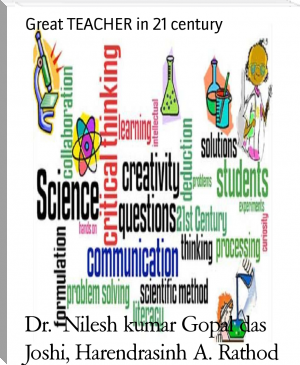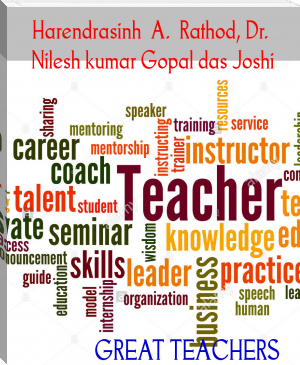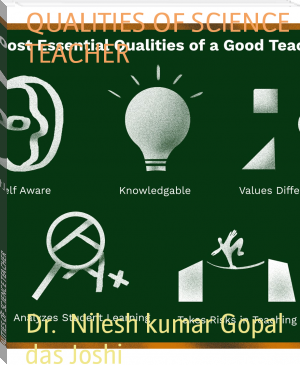Great TEACHER in 21 century by Dr. Nilesh kumar Gopal das Joshi, Harendrasinh A. Rathod (i have read the book a hundred times .txt) 📖

Book online «Great TEACHER in 21 century by Dr. Nilesh kumar Gopal das Joshi, Harendrasinh A. Rathod (i have read the book a hundred times .txt) 📖». Author Dr. Nilesh kumar Gopal das Joshi, Harendrasinh A. Rathod
For inspiration, empowerment, proven techniques and strategies in 21st century leadership check out my ONLINE COURSE: Leadership for the 21st Century. Hugely discounted to help you while you are stuck in isolation
Chapter 2 15 Characteristics of a 21st-Century Teacher
15 Characteristics of a 21st-Century Teacher
Recent technological advances have affected many areas of our lives, including the way we communicate, collaborate, learn, and, of course, teach. Those advances necessitate an expansion of our vocabulary, producing definitions such as digital natives, digital immigrants, and the topic of this post—21st-century teacher.
Obviously, teaching in the 21st century is an altogether different phenomenon; never before could learning be happening the way it is now—everywhere, all the time, on any possible topic, supporting any possible learning style or preference. But what does being a 21st-century teacher really mean?
15 CHARACTERISTICS OF A 21ST-CENTURY TEACHER
Learner-centered classroom and personalized instruction:As students have access to any information possible, there certainly is no need to spoon-feed them knowledge or teach one-size-fits-all content. Students have different personalities, goals, and needs, and offering personalized instruction is not just possible but desirable. When students are allowed to make their own choices, they own their learning, increase intrinsic motivation, and put in more effort—an ideal recipe for better learning outcomes.
Students as producers: Today’s students have the latest and greatest tools, yet the usage in many cases barely goes beyond communicating with family and friends via chat, text, or calls. Even though students are now viewed as digital natives, many are far from producing any digital content. They own expensive devices with capabilities to produce blogs, infographics, books, how-to videos, and tutorials, just to name a few, but in many classes they are still asked to turn those devices off and work with handouts and worksheets.
Sadly, often these papers are simply thrown away once graded. Many students don’t even want to do them, let alone keep or return to them later. When given a chance, students can produce beautiful and creative blogs, movies, or digital stories that they feel proud of and share with others.
Learn new technologies: In order to be able to offer students choices, having one’s own hands-on experience and expertise will be useful. Since technology keeps developing, learning a tool once and for all is not an option. The good news is that new technologies are new for the novice and and experienced teachers alike, so everyone can jump in at any time. I’ve used a short-term subscription to Lynda.com, which has many resources for learning new technologies. Go global: Today’s tools make it possible to learn about other countries and people firsthand. Of course, textbooks are still sufficient, yet there’s nothing like learning languages, cultures, and communication skills by actually talking to people from other parts of the world.It’s a shame that with all the tools available, we still learn about other cultures, people, and events from the media. Teaching students how to use the tools in their hands to visit—at least virtually—any corner of this planet will hopefully make us more knowledgable and sympathetic.
Be smart and use smartphones: Once again—when students are encouraged to view their devices as valuable tools that support knowledge (rather than as distractions), they start using them as such. I remember my first years of teaching when I would not allow cell phones in class and I’d try to explain every new vocabulary word or answer every question myself—something I wouldn’t even think of doing today.I’ve learned that different students have different needs when it comes to help with new vocabulary or questions, so there’s no need to waste time and explain something that perhaps only one or two students will benefit from. Instead, teaching students to be independent and know how to find the answers they need makes the class a different environment.
I’ve seen positive changes ever since I started viewing students’ devices as useful aids. In fact, sometimes I even respond by saying, “I don’t know—use Google and tell us all.” What a difference in their reactions and outcomes!
Blog: I have written on the importance of both student and teacher blogging. Even my beginners of English could see the value of writing for real audience and establishing their digital presence. To blog or not to blog should not be a question any more. Go digital: Another important attribute is to go paperless—organizing teaching resources and activities on one’s own website and integrating technology can bring students’ learning experience to a different level. Sharing links and offering digital discussions as opposed to a constant paper flow allows students to access and share class resources in a more organized fashion. Collaborate: Technology allows collaboration between teachers and students. Creating digital resources, presentations, and projects together with other educators and students will make classroom activities resemble the real world. Collaboration should go beyond sharing documents via email or creating PowerPoint presentations. Many great ideas never go beyond a conversation or paper copy, which is a great loss. Collaboration globally can change our entire experience. Use Twitter chats:Participating in Twitter chats is the cheapest and most efficient way to organize one’s PD, share research and ideas, and stay current with issues and updates in the field. We can grow professionally and expand our knowledge as there are great conversations happening every day, and going to conferences is no longer the only way to meet others and build professional learning networks. Connect: Connect with like-minded individuals. Again, today’s tools allow us to connect with anyone, anywhere, anytime. Have a question for an expert or colleague? Simply connect via social media: follow, join, ask, or tell. Project-based learning: As today’s students have access to authentic resources on the web, experts anywhere in the world, and peers learning the same subject somewhere else, teaching with textbooks is very 20th-century. Today’s students should develop their own driving questions, conduct their research, contact experts, and create final projects to share, all using devices already in their hands. All they need from their teacher is guidance. Build your positive digital footprint: It might sound obvious, but it is for today’s teachers to model how to appropriately use social media, how to produce and publish valuable content, and how to create sharable resources. Even though it’s true that teachers are people, and they want to use social media and post their pictures and thoughts, we cannot ask our students not to do inappropriate things online if we ourselves do them. Maintaining professional behavior both in class and online will help build positive digital footprint and model appropriate actions for students. Code: While this one might sound complicated, coding is nothing but today’s literacy. As pencils and pens were the tools of the 20th century, today’s teacher must be able to operate with today’s pen and pencil—computers. Coding is very interesting to learn—the feeling of writing a page with HTML is amazing. Even though I have a ways to go, just like in every other field, a step at a time can go a long way. Again, Lynda.com is a great resource to start with. Innovate: I invite you to expand your teaching toolbox and try new ways you have not tried before, such as teaching with social media or replacing textbooks with web resources. Not for the sake of tools but for the sake of students.Ever since I started using TED talks and my own activities based on those videos, my students have been giving very different feedback. They love it! They love using Facebook for class discussions and announcements. They appreciate novelty—not the new tools, but the new, more productive and more interesting ways of using them.
Keep learning: As new tools and new technology keep emerging, learning and adapting is essential. The good news is: It’s fun, and even 20 minutes a day will take you a long way.
Chapter 3 Who is a 21st Century Teacher?
Who is a 21st Century Teacher?
What does it mean to be a 21st century teacher? The term is frequently tossed around the media. So beyond being up-to-date with the latest classroom technology, what does a 21st century teacher actually look like?
The 21st century teacher looks forward to the future. They are aware of the ever-changing trends in technology and are in tune of what the future may bring to education. A good 21st century teacher is aware of the career opportunities that will be in the coming years for their students, and are always advocating towards forward thinking and planning to ensure all students will not be left behind.
Let’s take a look at a few key characteristics of a 21st century teacher:
· A Master of Technology in the Classroom
Technology in the classroom is moving at a rapid pace and the 21st century teacher moves right along with it. Classroom technology; whether it’s for lessons, assignments, or grading, can help students learn better and faster, and help make a teacher’s time more effective. A 21st century teacher does not have to have a class set of tablets in every child’s hand, or the latest Smart-board. But they can have a nice balance of educational tools in their classroom. An effective teacher knows what technology in the classroom can truly help transform their students’ education. They know what the best tools are, and how and when to use them.
· Knows How to Collaborate
An effective 21st century educator must be able to collaborate and work well in a team. Working with others is an important 21st century skill. Over the past few years, being able to collaborate effectively in the workplace has grown quite rapidly. Learning is deemed to be more effective when you can share your ideas and knowledge with others. Sharing your expertise and experience, communicating and learning.
· Is Adaptive
A 21st century teacher is able to adapt to whatever comes their way. Teaching is a career that has pretty much stayed the same over the past few decades. The tools have changed over the years (Smart boards have replaced chalkboards, tablets have replaced textbooks) but the practice has not. The 21st century teacher is able to look at their practice and adapt based on the needs of their students. They must be able to adapt their teaching style to include different modes of learning, adapt when a lesson fails, and adapt to new technology. They must be able to adapt to the curriculum and the requirements and be able to use their imagination to teach in creative ways.
· Is a Lifelong Learner
The 21st
 The desire to acquire knowledge about the surrounding world and human society is quite natural and understandable for a person. Life is so developed that an uneducated person will never occupy a high position in any field. Humanity in its mass, and each person individually, develops objectively, regardless of certain life circumstances and obstacles, but with different intensity. The speed of development depends on the quality of training.
The desire to acquire knowledge about the surrounding world and human society is quite natural and understandable for a person. Life is so developed that an uneducated person will never occupy a high position in any field. Humanity in its mass, and each person individually, develops objectively, regardless of certain life circumstances and obstacles, but with different intensity. The speed of development depends on the quality of training.




Comments (0)